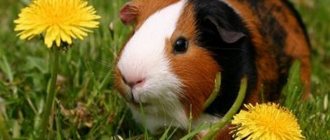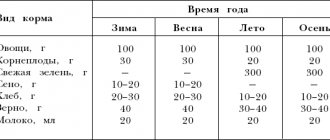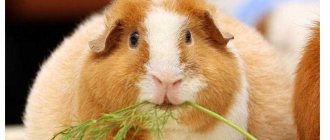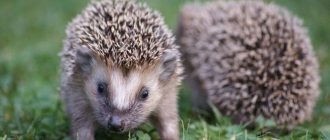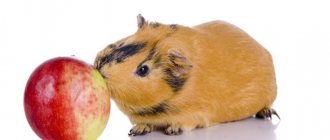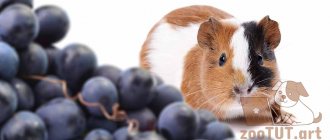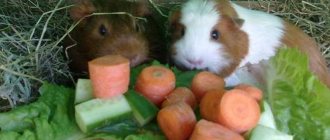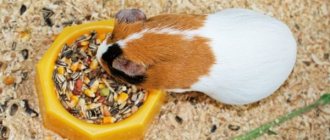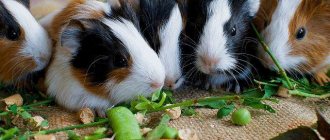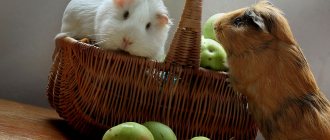Add vitamin C to your animal's diet. The well-being of guinea pigs depends on a number of conditions. Proper nutrition is the most important of them. The products included in the animals' diet provide them with nutrients and beneficial substances. Vitamin C, which is found in citrus fruits, is very important for guinea pigs.
With its deficiency, animals' metabolism is disrupted, immune defense is reduced and even high-calorie feeds are poorly absorbed.
However, not all rodents show interest in citrus fruits, although some enjoy eating these fruits.
In what cases should you not give
Citrus fruits are atypical foods for pigs and cause a sensitizing load on the body.
Therefore, they are contraindicated for digestive problems. At the same time, tangerines are quite allergic fruits; if your pet already has a tendency to such diseases or skin lesions, then they cannot be included in the diet. For the same reason, there are contraindications for young animals. They should not consume citrus fruits until their digestive system is fully formed. Pigs are prone to stress, new food is also one of the factors. Therefore, if the animal has never eaten tangerines before, and has an exciting situation in its life (moving to a new house, walking on the street, meeting another animal), then you should not try to appease it with such a treat. This will only worsen his condition.
During pregnancy and breastfeeding, citrus fruits are contraindicated for females.
Nutrition for pregnant pigs and newborn piglets
Pregnant pets must eat well and of high quality. The diet of furry mothers should be rich in proteins and vitamins. It is useful to give pregnant females carrots, beets, and wheat sprouts. You can periodically add a little milk to the water. Rosehip infusion brings great benefits to the body of a pregnant pig.
If the female who gave birth does not have milk, then the owner will have to feed the cubs on his own using a syringe. Artificial food for small piglets includes low-fat cream and the probiotic Linex. The cream is taken into the syringe and a tenth of the probiotic capsule is added to it. The resulting solution is nutritious and beneficial for the digestive system of babies. The food in the syringe is warmed to room temperature. Piglets take 1 ml of food every hour. Two-week-old babies can be switched to cereal porridge without milk. The piglets sit on the porridge until they get used to “adult” food.
Review and table of the most popular ready-made food for guinea pigs
Before giving preference to a certain brand of ready-made food, the owner needs to study its composition, as well as the advantages and disadvantages characteristic of each type of food.
Standard grain mixture "LittleOne" from the Mealberry brand
It is considered one of the best food for guinea pigs. It contains nutritious grass granules, grains of oats, wheat and barley, dried slices of carrots and apples and vegetable seeds. The food is enriched with vitamins and minerals necessary for the normal functioning of the digestive system of rodents.
LittleOne food
A food called "Crispy Muesli Guinea Pigs" produced by Versel-Laga
Contains dried herbs, herbal granules, cereal grains and dried vegetables. It also contains vitamin C and beneficial minerals.
Crispy Muesli Guinea Pigs food
"MenuVital" from the Vitakraft brand
The basis of the feed is oat and barley grains. Contains this food and alfalfa grass granules, Yucca extract, dried vegetables and vegetable fats.
Food "MenuVital"
JR Farm Classic
Produces good food for guinea pigs, containing grain and legume flakes, dried carrots, a mixture of meadow herbs (clover, burdock, plantain, yarrow), mint and parsley. It contains minerals and ascorbic acid.
JR Farm Classic food
Ready-made grain mixture “Animals” from the trading company Zoomir
It is made from seeds, dried vegetables and berries, herbal granules, cereal flakes and carob. It also includes a complex of vitamins and beneficial microelements.
Food "Animals"
Ready-made mixture “Vaka Lux” from the manufacturer Biosphere
The mixture includes vegetable flakes, granulated feed, grass granules, cereals and dried vegetables.
Food "Waka Lux"
CaviaComplete food from Versel-Laga Corporation
Considered the best pelleted food for guinea pigs. Its granules are made from grass, seeds, vegetables and fruits. It is also enriched with minerals and vitamins.
CaviaComplete food
Ready-made hay “VitaVerde” from the Vitakraft brand
It has gained popularity among owners of furry rodents, as it is high-quality dry straw that the guinea pig eats with pleasure.
Hay "VitaVerde"
According to reviews from guinea pig owners and breeders, the ranking of the most popular foods is as follows:
Rating of the best food for guinea pigs
| Feed | pros | Minuses | Estimated cost RUB. |
| LittleOne | The food contains no dyes and is readily eaten by guinea pigs. | The mixture is fatty and high in calories | 300 rubles |
| CaviaComplete | High fiber content | High price | 1300 rubles |
| MenuVital | Balanced composition, presence of vitamin C | Contains dyes | 400 rubles |
| CrispyMuesliGuineaPigs | Economical packaging with zipper | The food is too high in calories | 200 rubles |
| JRFarmClassik | Low grain content, affordable price | Contains dyes | 400 rubles |
| Animals | Contains a variety of ingredients | A large number of cereals | 100 rubles |
| Waka Lux | Balanced composition | Rodents do not eat all ingredients | 200 rubles |
Not only the health, but also the life of your furry pet depends on properly selected food and a balanced diet. Therefore, the issue of feeding should be approached with all responsibility and not risk the health of the rodent by treating it with forbidden delicacies and products of dubious quality.
What not to give to guinea pigs
The guinea pig is a herbivore. It has a long digestive tract, which is designed to digest coarse fibers. Therefore, the basis of his diet - 75% - should be plant foods, namely hay and grass. In addition, your pet’s menu should include plenty of fresh vegetables, fruits, berries, and granular food.
Since the body of this animal cannot independently produce vitamin C, which is very important for its normal functioning, this element must be supplied with food, namely with succulent food. However, not all vegetables and fruits are beneficial for the animal. Some of them can be given in small doses, many should never end up in your pet’s feeder.
Forbidden vegetables
There are few vegetables that should not be given to guinea pigs. Most of them can be included in the diet daily. Some are allowed to be fed, but in limited quantities. Cabbage, both white and cauliflower, is undesirable in a pig's feeder. It leads to bloating, upset, pain and discomfort in the abdomen.
Vegetables allowed for consumption should be given to the guinea pig only fresh. The maximum allowable amount per day is 200 g.
The list of vegetables that are allowed and prohibited for consumption by furry rodents can be found in the table:
| Can |
Can be done occasionally and in small quantities
It is forbidden
Cucumber, carrots, zucchini, pumpkin, turnips, celery (root), beets Tomato, bell pepper, avocado, Jerusalem artichoke, rutabaga, artichoke, cabbage Potatoes, onions, garlic, radishes, radishes, horseradish, legumes, corn
Berries and fruits
Fruits and berries are not recommended for the daily diet. They can be fed to the animal 2-3 times a week. They are a source of fiber. Among the fruits, there are some that are desirable in the pig’s menu and are prohibited. All berries can be consumed, but some are rare.
| Can |
Can be done occasionally and in small quantities
It is forbidden
Apples, pears, plums, grapes (except seeds), raspberries, strawberries, blueberries, cherries, sweet cherries, currants Apricots, bananas, melon, oranges, tangerines, watermelons, peaches, pineapples, kiwi, blackberries, rowan, cranberries, gooseberries, sea buckthorn Lemons, grapefruit, pomegranate, persimmons, dates
Animal products
There should be no animal products in the feeding of guinea pigs. Not only do they not need them, but they also pose a health risk. Thus, dairy products and cheese contain lactose, and rodents lack the enzyme that is responsible for digesting them. Therefore, once in the animal’s gastrointestinal tract, “milk” will lead to gas formation and diarrhea, which will cause considerable discomfort not only to the pet itself, but also to its owner.
Of course, there is no need for rodents to eat meat. It has no use in their diet. The digestive tract will not be able to digest this heavy product. The ban also applies to eggs.
Indoor flowers and herbs
Despite the fact that pigs are herbivores, they cannot be fed any indoor crops. Of the plants, the menu can only include meadow and garden greens. Most indoor ornamental crops contain substances that are toxic to animals. If they are consumed, severe poisoning may develop.
If we talk about meadow and garden herbs, sorrel, the ground part of onions and garlic, celandine, fern, sow thistle, wild rosemary, lavender, and serpentine are prohibited. These plants are poisonous to pigs. If you want to feed your pet green grass, then you should prefer carrot and beet tops, dill, plantain, clover, sage, chamomile, burdock, nettle, and echinacea.
Other contraindicated products
A domestic rodent should not be given food from the common table, for example, leftovers from consumed dishes. Fried, canned, salted, baked, boiled foods are strictly prohibited, even if vegetables, fruits and berries are prepared using one of these methods. Do not give foods with spices or just seasonings.
There is no place in your pet's feeder for anything that contains sugar - chocolate, sweets, cookies, etc. Even a small dose that enters the pig's body will provoke a spike in blood sugar, and if given frequently, this increases the risk of developing diabetes. diabetes Bakery products are not needed in the diet of rodents. The digestive tract will not be able to digest them.
Pet diet
In addition to vegetables, pigs eat dry food.
Guinea pigs are fed a specially formulated dry food, but eating vegetables and fruits is an important part of their diet. The daily dose of vitamin C is from 10 mg/kg to 30 mg/kg. When a guinea pig is pregnant or sick, the rate increases to a minimum of 30 mg/kg per day.
A small amount of grass, juicy tops and various vegetables are introduced into the daily food intake for rodents. In addition to hay and pelleted feed, add some fresh fruit. Good for supplementary feed:
- radish leaves;
- spinach;
- parsley;
- dandelion leaves.
In the autumn-winter period, it is recommended to introduce succulent food into the animal’s diet. A rodent should consume about 80-100 g of succulent food per day. This is only 20% of the daily requirement. The diet of an adult pet should be as varied as possible.
Rose hip
Rosehip is a rich vitamin and mineral complex. It contains vitamins C, E, PP, B1 and B2, minerals - calcium, manganese, potassium, magnesium, sodium, phosphorus, zinc, copper and iron. Guinea pigs can eat berries, flowers and rosehip leaves. Rose hips can be given to your pig fresh or dry, but the fuzzy seeds must be removed before feeding. Rosehip is very useful for a pet, as it strengthens the immune system, improves digestion, calms, restores the animal’s strength after illness or pregnancy, helps against atherosclerosis, with abdominal pain, and with the healing of wounds and cracks in bones. Guinea pigs can also be given rosehip infusion into their drinking bowl.
How can you tell if a rat is allergic to citrus fruits?
If, after you give your pet a piece of any citrus, he experiences the symptoms described below, then this may be a sign of an allergy:
- swelling of the rat's paws;
- itching;
- irritation;
- rash;
- the appearance of scabs. Rat with orange
In this case, you should contact your veterinarian. With proper care, allergies in rats can be treated quite easily and quickly, usually taking about 10 days. If the animal's paws are swollen, then they are treated with an antiseptic; this is also done if the eyes and ears are inflamed. During treatment, it is advisable to completely remove fruit from the rat’s diet.
In conclusion, we can say that you need to be extremely careful with citrus fruits and seeds; if you give permitted citrus fruits from the list, then only very rarely and in small quantities. Unfortunately, identifying an allergy in an animal to a particular product is often only possible through trial and error, but the main thing is to continue to care for your pet properly and do everything so that it does not have such a problem again. Citrus fruits can be safely replaced with other healthy and safe fruits and vegetables.
Is it possible to feed a rat fruit seeds and peels?
A small amount of citrus fruit pulp in a rat's diet provides it with essential vitamins, but what about the seeds and peel? They can be given quite a lot of different fruits; however, cherries, plums, apples, rowan berries, pears, persimmons, apricots and peaches should be pitted first. These bones contain hydrocyanic acid, which can cause poisoning of the animal.
Rat and orange Even one seed contains enough of this acid to bring the animal to death. Orange and tangerine seeds should also not be given. In general, you should forget about this; for all fruits, it is better to give some ripe and fresh pulp if you do not want health problems for your pet. You should not feed your pet the peel; it is preferable to always try to peel the fruit from it and give only the best pieces.
What and how to feed your guinea pig
The rodent menu includes fresh and dried herbs, fresh vegetables and fruits, and cereals. Unlike rats and hamsters, guinea pigs eat mostly grass and vegetables rather than grains. Grain should be in the diet of the main characters of this article, but in smaller quantities than their relatives.
List of products for the daily diet of pigs:
- Hay.
- Fresh plants: nettle, dandelion, chamomile, alfalfa, dill, burdock and lettuce.
- Fresh vegetables: carrots, cabbage, beets, cucumber, celery, pumpkin, zucchini.
- Fresh branches of fruit trees and shrubs: apple, raspberry, blueberry, pear. Willow, maple, and ash branches are also suitable.
- Fresh berries and fruits: apple, pear, banana, strawberry, cherry.
Stores sell special dry food for pigs. There is no consensus on whether it is necessary in the daily diet of an animal. Some breeders give their pets one tablespoon of food daily for each individual, considering this a necessity. Other owners limit themselves only to fresh food. But it is absolutely clear that you cannot feed animals with dry food alone. Fresh herbs and vegetables are required in the diet.
It is recommended to add treats to the usual menu two or three times a week. Pigs will love dried fruits and nuts. But they should not be the basis of the diet.
It is strictly forbidden to feed these rodents the following products:
- pasta, bread and other flour products;
- dairy and fermented milk products;
- sausage and meat, as well as fish and eggs;
- potato;
- sugar-containing products;
- mushrooms;
- onion and garlic;
- legumes (peas, beans, etc.), except peanuts.
You need to feed your pig 2-3 times daily. High-quality hay should always be available to the animal.
Your pet's diet should be varied. You cannot feed your rodent the same food every day.
The pig is given treats no more than 2-3 times a week, otherwise it may negatively affect the pet’s health.
You cannot leave an animal without food for a long time. If the pet does not eat for 18 hours, then irreversible changes will begin in its digestive system, which can lead to the death of the animal.
Pigs drink little water, but there should always be a supply of fresh boiled water in the cage.
In winter, instead of fresh herbs, the pig is fed sprouted grains.
The daily portion of food should not be more than 30% of his body weight. If you overfeed your pet, it will develop obesity.
The introduction of new products should be gradual. First, treat your pet with a small piece of a new type of food. Then you need to observe the condition of the animal to see if there are any changes. And if everything is fine with the pet, then you can introduce a new product into the regular diet.
Pigs are sensitive to the quality of food consumed. It is better to remove stale vegetables and rotten hay. Eating stale food will lead to digestive problems in the animal.
cucumbers
Most often, owners are interested in whether guinea pigs can eat cucumbers. These vegetables contain 2-6% dry matter - sugars, fiber, protein, some vitamins and microelements. 94-98% of the total mass of a cucumber is water, so this vegetable has little nutritional value. But, despite this, cucumber helps the rodent’s body digest other foods and absorb fats. You can give cucumbers to guinea pigs in small quantities and, preferably, your own, since poisoning often occurs due to the nitrates contained in purchased cucumbers. Overfeeding cucumbers can lead to digestive problems.
Oranges and tangerines
Citrus fruits are contraindicated for guinea pigs due to their high content of fruit acids.
Fruit acids irritate the skin and acidify urine. But guinea pigs are fed citrus pulp and peels treated with chemicals and rich in essential oils, which should not be done under any circumstances. When eating oranges, tangerines and other citrus fruits, your pet may experience cheilitis, or even death. And guinea pigs will eat whatever you give them.
Cherries, sweet cherries, apricots, peach, plums and other stone fruits contain large amounts of sugar and when feeding a large amount of them along with water to your pet, severe diarrhea occurs. If you want to feed your guinea pig cherries, apricots or other similar fruits, first remove the pit and offer the pig half a cherry or a tiny piece of apricot to start with. If the rodent reacts normally to this fruit, you can gradually increase the amount.
Under no circumstances should you give cherry, sweet cherry, apricot, peach, or plum pits, because they contain hydrocyanic acid.
It is not advisable to give exotic fruits - guava, lychee, mango, papaya, pineapple and others, as they can cause dangerous digestive upset. Some fruits, such as avocados, are toxic to rodents and cause diarrhea.
Bottle with drinker
Such an accessory will come in handy during street walks. It does not take up much space, weighs little and does not hinder movement. But you can offer the dog to quench his thirst at any time, and not wait until he starts drinking from a dirty puddle or lake overgrown with mud.
The device consists of a water container and a bowl equipped with a dispenser button. It allows you to release as much liquid from the bottle as the animal needs to quench its thirst. Sold in two volume options - 350 and 550 milliliters.
Price – 475 – 584 rub.
Another model of the same device has a folding shape, which makes it easier to carry. The transformer connects the bowl and the bottle, securely fixing them in such a compact state. The durable polymer material has good shockproof properties and can even resist dog teeth. True, this struggle will not be long and - if the owner is careless - then all the liquid will end up on the ground.
Volume 250 ml.
Cost – 133 – 148 rubles.
I like1I don't like
Is it healthy to feed guinea pigs citrus fruits?
Taking into account the needs and characteristics of pets, the diet is divided into three parts:
- Basic (usually grain, ready-made mixtures, green food).
- Treats (fruits, vegetables, specialized “snacks”).
- Mineral and vitamin supplements.
The body of guinea pigs does not have the ability to synthesize vitamin C on its own, but tangerines, saturated with it, are not the best source for furry animals. In addition, they contain other elements that make the digestive system harder.
Comparing other similar delicacies to the question of whether it is possible to feed guinea pigs tangerines, the answer is clear - it is possible, but in small quantities and no more than 2 times a week.
Several features of the diet of guinea pigs: rules are important
Pigs are absolutely contraindicated from eating animal products. The guinea pig is a herbivore, and it should only eat grass, tree branches, tree bark, and other plants.
You can also germinate oats, wheat or other healthy grains yourself at home. Pigs can also give sweet fruits, but it is better to serve them in small quantities.
The body of a guinea pig does not produce vitamin C. The animal can get it from food (twigs and leaves). Additionally, you can dissolve the vitamin in the drinking bowl.
If you follow these simple rules, your life will become noticeably easier. You will stop arguing about what your pet can do and what is strictly forbidden to him. The guinea pig will begin to receive healthy foods daily - twigs and leaves.
You will extend your pet's life if you analyze which plants are best to feed him and when. Your animal will grow up healthy, cheerful, and energetic. Be careful about those you have tamed!
Harvesting dry grass
If the greens are collected in an environmentally friendly place, then you do not need to wash them before giving them to your pets. If the grass is covered in dust or dirt, it should be washed in plenty of warm running water. But you shouldn’t treat hay with boiling water - hot water will not kill pathogenic bacteria, but it will significantly reduce the content of vitamins in plants. To harvest the grass for the winter, you can freeze it. To do this, it is finely chopped, placed in plastic bags and sent to the freezer.
Dry food for animals is also often made from green plants. For this purpose, herbs and leaves must be spread out in a dark, dry, well-ventilated area until completely dry. This dry food can be stored for up to six months in polyethylene or fabric bags. Dry herb preparations must be stored in a dry place away from direct sunlight.
Vegetable menu
Pigs have to look for vitamin C, which is responsible for the functioning of connective and bone tissues, from the outside, since their body is not able to produce it on its own.
Guinea pigs love apples, cucumbers and carrots.
Ascorbic acid enters the body from plant foods, including fresh vegetables (broccoli, bell pepper), amounting to at least 1 teaspoon per day.
Vegetables that can be given to guinea pigs include:
- . Rich in vitamins, minerals and pectins, which normalize intestinal motility.
- Carrot
. Positively affects the condition of the skin and coat, visual and auditory functions. In addition to root vegetables, it is allowed to feed tops. The beta-keratin (vitamin A) content gives urine an orange tint. - Bell pepper
. Rich in vitamin C, but dangerous in winter due to the amount of harmful nitrates. Only sweet varieties are allowed as food, while spicy ones lead to irritation of the mucous membranes. - Pumpkin
. Not only the pulp is eaten, but also the crust and seeds, which are rich in zinc and act as a prophylactic against helminthiases. - . Low in calories, have an anti-inflammatory effect and facilitate the absorption of fats. Not suitable as a main food and dangerous in winter (high nitrate content).
- Fresh peas
. It is recommended to feed your pets only fresh pods, without overusing the quantity. Dried grains should not be consumed, but some manufacturers add them to ready-made food. - . Requires competent control. It is introduced gradually to avoid excessive gas formation. Rich in sulfur, which synthesizes collagen and adds shine to the coat.
- Rutabaga
. Helps with constipation, facilitating peristalsis, and has a diuretic effect. Recommended for use in winter, when the choice of vegetables becomes limited. - Jerusalem artichoke
. The consumption of root vegetables enriched with starches should be limited to avoid intestinal disorders. The remaining parts, rich in fiber and amino acids, are allowed on an ongoing basis.
Controversial and dangerous vegetables include:
- Tomatoes
. In their green (unripe) form they are considered poisonous due to solanine; consumption of the tops is also not recommended. Ripe tomatoes, containing a large amount of vitamins, undergo destruction by dangerous poison, so they can be included in the diet in limited quantities. Avoid tomato abundance, which provokes intestinal upset. - . Another vegetable rich in poisonous solanine and starchy substances.
- Melon
. Dangerous for the development of diabetes due to the abundance of sugars. - . Essential oils irritate the mucous membranes and cause bloating.
- . Has a laxative effect. Not recommended during pregnancy, lactation and older age
- . Only green parts are allowed for food. Grains are dangerous due to the abundance of starch, which interferes with digestion and leads to weight gain.
Vegetables
Can guinea pigs have radishes?
It is permissible to use only radish tops. The root vegetable contains essential oils that can cause irritation to the mucous membranes and respiratory tract of the animal. The vegetable also causes bloating. Therefore, it is not recommended to give radishes to pigs.
Can guinea pigs eat celery?
Celery can be given in any form - stems, leaves, roots. This vegetable is included in many dry food for rodents. Celery is enriched with vitamins B, PP, E, C, A and contains phosphorus, zinc, potassium, calcium, iron and magnesium. Before eating, celery must be washed thoroughly, especially the root.
Can guinea pigs eat tomatoes?
Ripe fruits can be included in the food. Tomatoes are well absorbed by animals and contain vitamin C and carotene, which are beneficial for their body. Green tomatoes contain solanine, which can negatively affect your pet’s health.
Too many tomatoes in an animal's menu can cause loose stools.
Can guinea pigs eat cabbage?
Cabbage can be included in the animal's diet. Cabbage contains many vitamins and other substances necessary for pigs:
- ascorbic acid;
- B vitamins;
- vitamins of the PP group;
- folic acid;
- sulfur;
- calcium;
- potassium;
- phosphorus;
- amino acids;
- microelements.
The vegetable is able to keep the animal’s fur in excellent condition and strengthen its immunity. The top dried leaves should be given. It is preferable to feed guinea pigs Chinese cabbage and broccoli. White cabbage can cause bloating.
Can guinea pigs eat potatoes?
Green and sprouted potatoes are contraindicated for guinea pigs. Raw vegetables can be given occasionally, cut into small pieces. Boiled potatoes can be offered to your pet separately or added to grains and other foods.
The vegetable contains solanine, which can harm the health of the animal if the pet eats too many potatoes. The pig will become passive and catch cold quickly.
Can guinea pigs eat beets?
Beetroot contains many substances useful for animals: vitamins C, A and B, potassium, magnesium, phosphorus, iron. In excess, the vegetable contains fiber, so it acts on the animal’s body as a laxative. Store-bought root vegetables may contain nitrates, which are very harmful to the small body of guinea pigs. It is better to offer your pet homemade crops. The composition also contains a large amount of oxalic acid, so it is better to limit the consumption of this product.
It is recommended to give beets starting from 2 months; they are especially useful in winter and spring, when there are no fresh vegetables. The daily dose should not exceed 200 g, and it is better to exclude beets from the diet of pregnant and lactating pigs so as not to provoke an upset stomach. Beets turn stool and urine red, so if your animal has eaten them, don’t be alarmed by such changes.
Can guinea pigs eat pumpkin?
Pigs can be given all varieties of pumpkin that humans eat. For the digestion of herbivorous animals, such a product will be familiar and useful. Pumpkin contains vitamin C, calcium and phosphorus necessary for rodents. It should be borne in mind that this low-calorie vegetable will not be able to saturate the pig completely, so it is better to give pumpkin to guinea pigs as a treat.
Can guinea pigs eat bell pepper?
Another storehouse of ascorbic acid is bell pepper. Before use, the vegetable must be thoroughly washed and chopped, and the seeds removed. It is better to give the product together with dry food.
Green peppers containing solanine should not be given to animals, as should peppers in the form of hot seasonings. Spicy foods will damage the mucous membranes.
Can guinea pigs eat cucumber?
Cucumbers don't have as many nutrients as other vegetables. You can offer your pet a cucumber. The vegetable can harm your pet's health by causing digestive problems only if consumed in large quantities.
Possible problems
Animals, like people, can suffer from overeating. The stomach is not always able to process excess amounts of food, which negatively affects the pet’s condition. And excessive consumption of sweets does not have the best effect on health.
Do not forget that the Product given to the rodent must be of high quality. This will protect your pet from poisoning and diarrhea. In addition, banana is considered an astringent product.
An excessive amount of such treats will not allow the animal to go to the toilet in a timely manner. And irregular bowel movements and retained excrement in the body have a negative impact.
Overeating and poor-quality products harm the animal
It is important to remember that it is important to approach your pet’s nutrition as responsibly as you do your own.
Two approaches to feeding guinea pigs
When it comes to choosing a diet for furry rodents, the opinions of owners and breeders are divided.
Some believe that dry food containing grain and pressed granules from cereals and grass is contraindicated for guinea pigs, since the basis of their menu should be hay, grass and succulent food.
Adherents of dry food claim that ready-made food from well-known manufacturers contains all the necessary elements and ingredients for animals, and in limited quantities, grains are even beneficial for them.
In fact, these two options have both advantages and disadvantages, so each owner must decide for himself which type of feeding to give preference to.
Option 1: Grain-free diet
The main part of this diet consists of hay and fresh grass. As an additional food, fans of grain-free feeding give guinea pigs pieces of vegetables and fruits and berries twice a day.
A grain-free approach to guinea pig nutrition includes a wide variety of vegetables.What to consider when choosing this type of feeding:
- The pet's menu should be varied, so every day succulent food should include five types of vegetables and fruits. For example, on the same day you can give your guinea pigs slices of zucchini, carrots, peppers, apples and raspberries. And on the second, feed with pieces of pumpkin, turnip, cucumber, pear and blueberries.
- Vegetables and fruits must be environmentally friendly. It is unacceptable to give pets foods treated with chemicals.
- Uneaten slices of vegetables and fruits must be removed from the cage immediately. Otherwise, the process of rotting begins in them and, after eating such a product, the pig may become poisoned.
Among the advantages is the fact that the owner will not need to spend money on purchasing ready-made grain or granular mixtures.
If we talk about the disadvantages, the owner will have to make sure that there are several types of fresh fruits and vegetables in the refrigerator all year round, but in winter this is quite problematic and costs the owner a lot of money.
Option 2: feeding grain or pelleted mixtures
The grain approach to feeding pigs involves only one tablespoon of grain per day, the rest is vegetables and hay.
What you should know when choosing this type of food:
- You should buy dry mixtures only from trusted manufacturers. Cheap food contains a lot of grains and dried sweet fruits, which are harmful to the health of the animal;
- The guinea pig is given no more than a tablespoon of dry food per day and must supplement the diet with juicy food;
- if the animal is not accustomed to dry food, then the pet should be accustomed to it gradually, starting with half a teaspoon per serving;
- Such food is quite high in calories, so it is not advisable to feed dry mixtures to rodents that move little.
The advantage of grain food is that it is hard, so it helps the animal grind its teeth.
If we talk about the downsides, high-quality food is quite expensive. Another disadvantage is that such food can be difficult to find in a pet store and often has to be ordered on Internet sites.
General feeding rules
The recommended daily ratio of all types of food looks like this:
- dry food – 5-10% (no more than a tablespoon);
- juicy food – 30%;
- hay – 60%.
If there is no dry food on the menu, an adult pig should eat approximately 150 g of vegetables per day. She is served vegetables every day, and is occasionally pampered with berries and fruits. Vegetable dishes must be supplemented with leafy greens, which compensate for the lack of vitamins.
Do not keep your rodent on a mono-diet, feeding it only carrots or beets: this will cause health problems. It’s great if there are different products on his table every day: parsley will be replaced by dill/basil, and celery by carrots/zucchini. A typical daily diet consists of three types of vegetables and herbs.
Do not forget to establish an uninterrupted supply of hay (especially during the cold period): the guinea pig chews it constantly, without limiting itself in volume. Hay normalizes digestion and is necessary for proper grinding of teeth.
Legume and legume-cereal hay is considered the most valuable. The rodent will also thank you for the vitamin herbs (nettle, alfalfa and clover) that you will prepare in the summer. These plants will be an excellent feed for growing and pregnant animals.
Return to content
Grains, nuts and seeds
Most guinea pig owners purchase ready-made grain mixtures. As a rule, animals calmly eat purchased food in combination with succulent foods and feel great for some time. However, if the owner of the rodent did not pay attention to the nutritional pattern of his ward, the animal may soon begin to have health problems.
Some pigs choose from a grain mixture and eat only sweet dried fruits and seeds, which contain a lot of fats and carbohydrates. This often leads to obesity, liver disease, and heart failure. The most common symptoms of animal malnutrition are:
- diarrhea;
- bloating;
- the appearance of dental problems;
- constipation;
- shifting the nutritional balance from succulent feed to grain.
If at least 2 of the listed signs are observed, it is necessary to urgently change the grain mixture. You should choose a composition with a lower carbohydrate content, which has a predominant amount of wild grains.
You can prepare the grain mixture yourself
But it is important to remember that cereals should not be boiled or scalded with boiling water. They are mixed with grains and given to pets in small quantities (30% of the diet)
Table 5. Permitted and prohibited components of the grain mixture.
| Can | It is forbidden |
| Barley grains, lentils, rolled oats, oats (unpeeled), pearl barley. | Millet, corn grits, rice grains, buckwheat. |
When choosing combinations of grain mixtures, it is necessary to take into account the age of the animal, the degree of its mobility, the time of year, and the weight of the rodent. This will help avoid problems with obesity and the development of gastrointestinal pathologies.
Can a guinea pig eat nuts and seeds?
These products add variety to the diet of pet rodents and saturate it with healthy fats. When feeding furry pets with seeds, you need to follow the following rules:
- freshness and integrity of products;
- preliminary peeling;
- lack of heat treatment;
- compliance with the daily proportion of products in the diet (approximately 20%).
It is recommended to treat pigs with raw sunflower and pumpkin seeds. Flaxseeds are allowed to be added to the main feed only occasionally. Cannabis seeds should not be given to guinea pigs.
The question of whether nuts should be added to the rodent menu has long been controversial. Most experts believe that with a certain amount of moderation, nuts can be given to physically healthy, very active guinea pigs.
Hazelnuts and walnuts are ideal for this type of rodent. They are introduced into the menu once every 7–8 days, 2–3 nucleoli. Peanuts and pine nuts must be excluded from the diet of animals. These foods are too high in calories and can cause obesity in sedentary pets.
Almonds contain hydrocyanic acid. Excessive feeding of such nuts may cause the animals to die. It is better to offer young animals and pregnant females walnuts in combination with dill seeds.
The diet of a domestic rodent must be properly balanced and not overloaded with fats and carbohydrates. It's okay if your pig chews dry grass all the time. This is only good for her; the animal’s teeth must be ground down all the time.
For sedentary rodents, the option of excluding grain components from the diet is ideal. This will reduce the risk of their obesity. But in this case, the share of juicy foods in the daily menu (especially vegetables) should increase significantly.
Timely, vitamin-rich nutrition will allow your guinea pig to remain healthy and active for many years.
What fruits and berries can guinea pigs eat?
Every owner of a guinea pig or other animal wants to treat their pet to some kind of treat. Fruits or berries are perfect treats for guinea pigs. These products should always be in your pet's diet. Fruits and berries are a source of many vitamins and minerals. If greens are always present in your pig’s diet, then fruits can be offered three to four times a week in small quantities. Some pets are prone to cheilitis. Such individuals should be given fruit even less often. But not all types of treats can be given to rodents. So what fruits and berries can guinea pigs eat? Let's figure it out.
Watermelon
Guinea pigs can be given a little watermelon during the summer season. Try to give ripe pulp, and it is advisable not to give the white part closer to the rind, since it is in this part that nitrates accumulate. For the same reason, pigs should not be given early vegetables. Watermelon is a diuretic, so indulge your pet with it infrequently.
The same goes for melon. This vegetable is given from your own garden or purchased in season. It is also not recommended to give melon frequently; it is very sweet and can contribute to the development of diabetes.
We tried to consider in as much detail as possible and give answers to the question “What vegetables can guinea pigs eat?” As you can see, most vegetables are not only possible, but also should be given to guinea pigs. The most important thing is a properly formulated and balanced diet for your pet, including products grown without chemicals. To keep your guinea pig healthy and cheerful, stick to proper nutrition and your pet will thank you with its playful behavior and healthy appearance.
So, we have dealt with the question of what vegetables can guinea pigs eat, but we described in this article whether your pet can eat grass. You may be interested in this information.
https://nalugah.ru/zhivotnovodstvo/morskie-svinki/chem-mozhno-i-nelzya-kormit-morskuyu-svinku.htmlhttps://msvinkam.ru/pitanie/chem-kormit-morskuyu-svinku.htmlhttps:// moy-homyachok.ru/morskie-svinki/kakie-ovoshhi-mozhno-morskim-svinkam.html
Why can't hamsters eat citrus fruits?
Some of the most popular fruits that can be found in any grocery store are citrus fruits. Tangerines and oranges contain large amounts of organic acids, sugar, vitamin C and other vitamins and minerals. The peel of these fruits is rich in essential oils.
At first it may seem that such fruits will be useful for everyone, including such small pets as hamsters, but this is not so. For hamsters, eating citrus fruits is extremely dangerous to their health, so feeding them such foods is strictly prohibited. The reasons are as follows:
- Citrus fruits are rich in vitamin C. Hamsters can produce this vitamin on their own. If an animal is fed with tangerine or orange, an excess of vitamin C will occur in the body, which is the cause of the development of hypervitaminosis.
- The presence of organic acids in fruits, especially citric acid, negatively affects tooth enamel. Since hamsters’ teeth have only one-sided enamel coating, eating such fruits will very quickly lead to its destruction.
- The acids that citrus fruits are rich in have an irritating effect on the mucous membranes of the gastrointestinal tract, which can lead to various diseases.
Vintage basket
Here we are dealing with a representative design in the style of modern rural fashion. Best suited for lovers of cycling or short distance travel on scooters. The basket itself is woven from flexible willow and equipped with an openwork wire lid, which prevents the cat from wanting to get out while moving. At the first glance at such a carrier, one is reminded of idyllic pictures from centuries ago, when food from the market was transported in a similar way on bicycles. The entire structure is conveniently attached to the steering wheel using leather straps and does not require much time for preparation.
The advantage of the option under consideration is, of course, its original design and originality. The downside is limited functionality. Although, if desired, the basket can be used for its intended purpose.
Price – 1,128 – 1,708 rubles.
Other citruses in the life of rats
Above, we discussed only the two most allergenic citrus fruits as food for decorative rats, but the citrus family does not end with tangerines and oranges. All recommendations are given in the case when the pet does not have allergies and the animal tolerates citrus fruits well.
Grapefruit
The pulp can be given from time to time in small quantities. The main thing is not to overdo it, as it contains a lot of acid.
Lemons and limes
You can give a small piece, very rarely. Bones and seeds should not be given because they contain the glycoside amygdalin, which, when decomposed, forms poisonous hydrocyanic acid.
Pomelo
Give only the pulp in small quantities, as it increases acidity. Pomelo peel is a carcinogen for rats, especially for males.
Sweetie
Sweetie, also known as pomelo, is essentially a hybrid of pomelo and white grapefruit. However, it has practically no seeds; you can give it a little pulp.
Is it possible or not to give tangerine peel?
It is better to peel and remove the skins and films from the tangerine.
Tangerine peel, zest and seeds contain many essential oils, aldehydes, and esters. To give the fruit a marketable appearance, many manufacturers treat the peel with special chemicals. It is difficult to wash them off with water.
It is not advisable to give tangerine peel to pigs, as it can cause serious poisoning. It is better to clean the tangerine slice from films and seeds.
Owners' opinions about the benefits of tangerines and oranges are divided. Here it is important to take into account the individual preferences of the pet and follow the norm.
Owners' opinions about the benefits of tangerines and oranges are divided. Here it is important to take into account the individual preferences of the pet and follow the norm.
What other foods are contraindicated for pigs?
What is not poisonous to humans can be destructive to the delicate body of a guinea pig.
Products that should be included in the diet in very small quantities:
- hazelnut;
- Walnut;
- seeds (sunflower, pumpkin, dill, sesame).
Sweets should never be given to a rodent. Candies, chocolate, marshmallows, halva are heavy foods that will lead to poisoning. Even the smallest amount of chocolate acts as a strong poison on the pig’s body.
You should not tempt fate and give the animal exotic fruits, no matter how much he begs for them. The pig is not given baked goods (including crackers, bagels), cookies, boiled porridge, soups and borscht in any form. The digestive system of these animals is not adapted to thermally processed foods.
Results
In conclusion, I would like to say that not everything that your guinea pig eats will be good for it. Do not try exotic products on her. If you don’t know whether your guinea pig can eat this or that product, it’s better not to feed it. A rodent in captivity cannot distinguish between products that are not healthy for it and therefore will eat everything you offer. On forums you can often see messages that some owners' guinea pigs eat almost all the foods on the prohibited list. But do not experiment on your pet; give him only vegetables, grass, herbs and fruits growing in our country. Believe me, without oranges, tangerines, bananas, kiwis and other harmful fruits, they will survive and live a long and happy pig life, delighting you.
« Previous entry
